Places
Beta Orionis System
Beta Orionis was the “true” Rigel, a bright blue binary system located 773 light years from the Sol System. The system had at least seven planets, including Rigel VII, and was located in the Beta Quadrant.[2] Rigel VII was first visited by Humans in 2254.[1, 2]
References
Beta Rigel System
Star system with at least ten planets located in the Deneva Sector of the Beta Quadrant, named for its apparent proximity to the “true” Rigel, Beta Orionis, as viewed from Earth.[2] The system was first visited by Humans in 2151.[1] Planets include Rigel VI and Rigel X.[2]
References
Star, Type-O
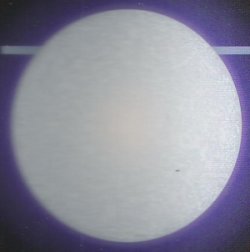
Type-O Star (STSC)
Dark blue star. Temperatures ranged from 28,000 to 50,000°K. O-Type stars were composed of ionized atoms, especially helium.
Each spectral class (O, B, A, F, G, K, M) was divided into 10 subclasses, ranging from 0 (hottest) to 9 (coolest). Stars were also divided into six categories according to luminosity: Ia (most luminous supergiants), Ib (less luminous supergiants), II (luminous giants), III (normal giants), IV (subgiants), and V (main sequence and dwarfs). For instance, Sol was classified as G2V, which meant that it was a relatively hot G-Type main sequence star. In addtion, classes R, N, S, T, Q, and W were used for relatively rare star types not found on the main sequence.[1]
O-Type stars
- Mintaka: O1-3III
References
- 1. “Star Trek: Star Charts.” Star Trek (Uncategorized). Book. October 2002.
Star, Type-M

Type-M Star (STSC)
Red star. Temperatures ranged from 2500 to 3500°K. M-Type stars were composed of ionized atoms, especially helium.
Each spectral class (O, B, A, F, G, K, M) was divided into 10 subclasses, ranging from 0 (hottest) to 9 (coolest). Stars were also divided into six categories according to luminosity: Ia (most luminous supergiants), Ib (less luminous supergiants), II (luminous giants), III (normal giants), IV (subgiants), and V (main sequence and dwarfs). For instance, Sol was classified as G2V, which meant that it was a relatively hot G-Type main sequence star. In addtion, classes R, N, S, T, Q, and W were used for relatively rare star types not found on the main sequence.[1]
› Continue reading
Star, Type-K
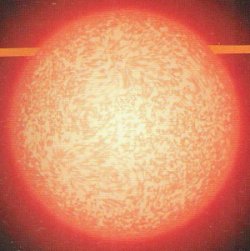
Type-K Star (STSC)
Orange star. Temperatures ranged from 3500 to 5000°K. K-Type stars were composed of neutral metals.
Each spectral class (O, B, A, F, G, K, M) was divided into 10 subclasses, ranging from 0 (hottest) to 9 (coolest). Stars were also divided into six categories according to luminosity: Ia (most luminous supergiants), Ib (less luminous supergiants), II (luminous giants), III (normal giants), IV (subgiants), and V (main sequence and dwarfs). For instance, Sol was classified as G2V, which meant that it was a relatively hot G-Type main sequence star. In addtion, classes R, N, S, T, Q, and W were used for relatively rare star types not found on the main sequence.[1]
› Continue reading
Star, Type-G
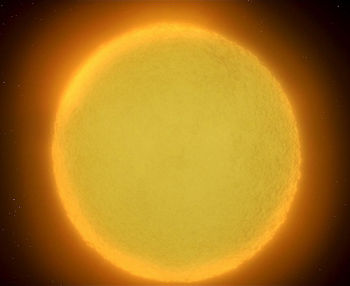
Type-G Star (ST-04)
Yellow star. Temperatures ranged from 5000 to 6000°K. G-Type stars were composed of ionized calcium and both neutral and ionized metals.
Each spectral class (O, B, A, F, G, K, M) was divided into 10 subclasses, ranging from 0 (hottest) to 9 (coolest). Stars were also divided into six categories according to luminosity: Ia (most luminous supergiants), Ib (less luminous supergiants), II (luminous giants), III (normal giants), IV (subgiants), and V (main sequence and dwarfs). For instance, Sol was classified as G2V, which meant that it was a relatively hot G-Type main sequence star. In addtion, classes R, N, S, T, Q, and W were used for relatively rare star types not found on the main sequence.[1]
› Continue reading
Star, Type-F
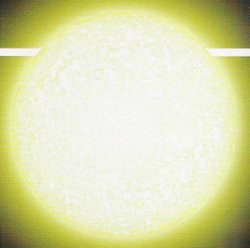
Type-F Star (STSC)
White star. Temperatures ranged from 6000 to 7500°K. F-Type stars were composed of hydrogen and ionized metals, as well as calcium and iron.
Each spectral class (O, B, A, F, G, K, M) was divided into 10 subclasses, ranging from 0 (hottest) to 9 (coolest). Stars were also divided into six categories according to luminosity: Ia (most luminous supergiants), Ib (less luminous supergiants), II (luminous giants), III (normal giants), IV (subgiants), and V (main sequence and dwarfs). For instance, Sol was classified as G2V, which meant that it was a relatively hot G-Type main sequence star. In addtion, classes R, N, S, T, Q, and W were used for relatively rare star types not found on the main sequence.[1]
› Continue reading
Star, Type-B

Type-B Star (STSC)
Blue star. Temperatures range from 10,000 to 28,000°K. B-Type stars are composed of Neutral helium and some hydrogen.
Each spectral class (O, B, A, F, G, K, M) was divided into 10 subclasses, ranging from 0 (hottest) to 9 (coolest). Stars were also divided into six categories according to luminosity: Ia (most luminous supergiants), Ib (less luminous supergiants), II (luminous giants), III (normal giants), IV (subgiants), and V (main sequence and dwarfs). For instance, Sol was classified as G2V, which meant that it was a relatively hot G-Type main sequence star. In addtion, classes R, N, S, T, Q, and W were used for relatively rare star types not found on the main sequence.[1]
› Continue reading
Star, Type-A
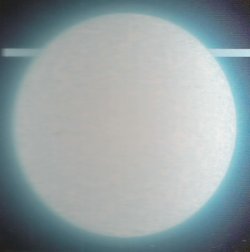
Type-A Star (STSC)
Light blue star. Temperatures ranged from 7500 to 10,000°K. A-Type stars were composed of strong hydrogen and some ionized metals.
Each spectral class (O, B, A, F, G, K, M) was divided into 10 subclasses, ranging from 0 (hottest) to 9 (coolest). Stars were also divided into six categories according to luminosity: Ia (most luminous supergiants), Ib (less luminous supergiants), II (luminous giants), III (normal giants), IV (subgiants), and V (main sequence and dwarfs). For instance, Sol was classified as G2V, which meant that it was a relatively hot G-Type main sequence star. In addtion, classes R, N, S, T, Q, and W were used for relatively rare star types not found on the main sequence.[1]
A-Type stars
- 40 Eridani B: AVII
- Sirius A: A0-1V
References
- 1. “Star Trek: Star Charts.” Star Trek (Uncategorized). Book. October 2002.
Planet, Class-Y
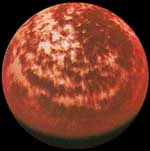
Tholia (STSC)
Demon. Age ranged from 2-10 billion years. Diameter was 10,000 to 50,000 km. Typically located in the Hot Zone, Ecosphere, or Cold Zone of a planetary system. Surface temperatures could exceed 500°K. Atmosphere was turbulent, and saturated with toxic chemicals and thermionic radiation. May have contained mimetic or crystalline-based life forms. Classes X, Y, and Z were reserved for planets with environments particularly hostile to humanoid life.[1]
Class-Y Planets:
References
Categories
- Animated Series (60)
- Articles (28)
- Books (447)
- Cast & Crew (79)
- Comics (22)
- DS9 (328)
- Early Voyages (125)
- Education (5)
- Enterprise (373)
- Excelsior (36)
- Food (19)
- Games (223)
- Klingon (70)
- Library (1,543)
- Logs (593)
- Lost Era (55)
- Medicine (18)
- Merrimac (1)
- Mirror (35)
- Miscellaneous (13)
- New Frontier (54)
- Next Generation (635)
- Original Series (681)
- Personnel (436)
- Places (369)
- Politics (12)
- Recreation (10)
- SCE (41)
- Science (1)
- Shatnerverse (9)
- Ships (455)
- Site Updates (98)
- Starfleet Academy (86)
- Stargazer (42)
- STO (61)
- Technology (45)
- Titan (59)
- To Boldly Go (1)
- TV/Film (214)
- Uncategorized (4)
- Vanguard (76)
- Voyager (236)
- Weapons (27)
- Xenology (54)